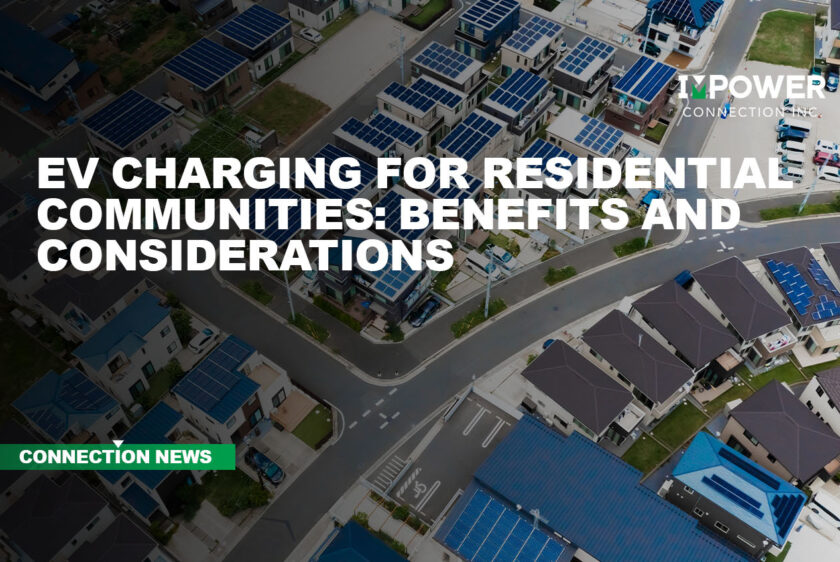Welcome to Impower Connection, your trusted partner in bringing EV charging solutions to multi-family residential communities such as apartments, townhomes, condominiums, and senior living. As electric vehicles (EVs) gain popularity, it’s essential to provide convenient and accessible charging options for residents in residential communities. In this blog, we will explore the benefits of EV charging for multi-family residential communities and highlight key considerations for implementing community charging station solutions. At Impower Connection, we are committed to delivering comprehensive EV charging infrastructure that caters to the unique needs of various multi-family residential communities.
1. Benefits of EV Charging for Multi-Family Residential Communities:
Implementing EV charging infrastructure in residential communities offers numerous advantages including attracting and retaining residents. Tenants are attracted to communities that offer charging for these reasons:
- Convenience and Accessibility: Residential EV charging stations provide convenient and accessible charging options for residents, enabling EV drivers charge at their homes so they start each day with a fully charged battery.
- Cost Savings: Charging at home allows community residents to take advantage of lower electricity rates often offered at night when the grid is utilized less. By installing residential charging stations, residents can reduce their overall vehicle expenses.
- Increased Property Value: EV charging infrastructure adds value to multi-family residential properties because having the ability to charge EVs at home, attracts buyers and renters who want the convenience of charging while they are in the comfort of their own home. This amenity is and will be even more valuable over time, differentiating the community from others.
2. Considerations for Implementing Community Charging Solutions at Multi-Family Communities:
When implementing EV charging infrastructure in residential communities, several considerations should be taken into account:
- Charging Infrastructure Design: Determine the optimal number of charging stations based on the community’s size and projected EV adoption rate. Collaborate with experienced professionals to ensure efficient placement, convenient accessibility, and proper electrical capacity planning.
- Homeowners Association (HOA) Collaboration: Engage with the HOA or community management to ensure compliance with community guidelines or architectural requirements. Seek their input to create charging policies that align with the community’s needs and lifestyle.
- Billing and Management Systems: Establish billing and management systems for residents using the charging stations. There are many brands of chargers and point-of-sale platforms. Consider options such as individual metering, shared billing, or subscription-based models to allocate costs fairly and transparently among users. Research which chargers are compatible with the cloud platform that meets your needs for billing and metering.
- Future Scalability: Plan for future scalability by considering the community’s long-term growth and potential EV adoption rate. Design the charging infrastructure to accommodate additional charging stations and anticipate any necessary electrical upgrades to support the increased demand.
3. Promoting EV Adoption and Education:
Educating current residents about forthcoming or new EV charging stations is vital to successful EV charging infrastructure implementation in multi-family residential communities. This can be achieved by:
- Education and Outreach: Conduct educational sessions to inform residents about the advantages of EV ownership such as lower cost of ownership and reduced tailpipe emissions. Address any concerns or misconceptions they may have and provide resources to assist community members in making informed decisions. If you already have EV chargers, promote the chargers to your residents and conduct demonstrations on how they work. Help new residents with EVs connect to your cloud platform.
- Incentives and Rebates: Stay informed about local, state, and federal incentives or rebates available for community EV charging infrastructure. Share information about these incentives with residents to encourage participation and help ease the transition to EV ownership.
- Community Engagement: Foster a sense of community by organizing EV-related events or activities. This could include EV ride-and-drive events, EV showcase days, or informational sessions with EV experts. Encouraging resident participation and engagement helps build a supportive and enthusiastic EV community.
Conclusion:
EV charging infrastructure in multi-family communities such as apartments, condominiums and mixed-use developments brings numerous benefits, including convenience, cost savings, and increased property value. By considering factors such as infrastructure design, HOA collaboration, billing systems, and future scalability, residential communities can successfully implement community charging solutions. Promoting EV adoption and providing education and support are key to creating a vibrant and sustainable EV community within the residential setting. At Impower Connection, we understand the unique requirements of residential EV charging and offer comprehensive solutions tailored to meet the needs of residential communities.
Visit our website at www.impowerconnection.com to learn more about our residential charging solutions and how we can assist you in implementing EV charging infrastructure for your residential community. Together, let’s empower residents with convenient and sustainable charging options, enhancing their EV ownership experience and air quality in your community.







